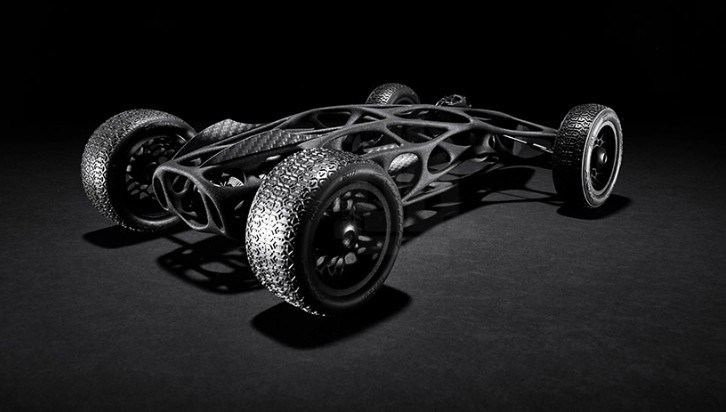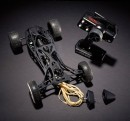A team of three - Max Greenberg, Sammer Yeleswarapu and Ian Cullimore - developed a beautiful black RC car they 3D printed as one piece. Not only does the vehicle look like something from another world, but it’s powered by a 16-foot rubber band that propels it at 30mph.
Dubbed Cirin, the Remote Controlled car is what the three brainiacs have come up with for the formula E race at the Pasadena, California-based Art Center College of Design. Call it an art project with futuristic influences or an engineering project with vintage nuances, either way this 1950s Formula One inspired car is beautiful. But let us get closer.
As we said, the RC car is powered by a 16-foot rubber band that propels it at upwards of 30 mph. This will only last for a few hundred feet, while braking and steering will be operated by the battery-powered remote. “We focused on creating a vehicle that would combine all of our past engineering education with the sculpture and industrial design skills we have acquired at art center,” Greenberg told to Design Boom.
He added that the chassis of the car is inspired by the truss structures found inside the bones of a birds wing. This also allows for the structure to be light, yet rigid, in other words fast, yet powerful. The manufacturing of the body was sponsored by advanced 3D printing company named Solid Concepts, that used selective laser sintering of a proprietary nylon powder formulation.
The bio-truss structure is built to withstand the immense torsional stress put on the frame by the wound band, which, through the machined aluminum gears, transfers power to the rear axle.
As we said, the RC car is powered by a 16-foot rubber band that propels it at upwards of 30 mph. This will only last for a few hundred feet, while braking and steering will be operated by the battery-powered remote. “We focused on creating a vehicle that would combine all of our past engineering education with the sculpture and industrial design skills we have acquired at art center,” Greenberg told to Design Boom.
He added that the chassis of the car is inspired by the truss structures found inside the bones of a birds wing. This also allows for the structure to be light, yet rigid, in other words fast, yet powerful. The manufacturing of the body was sponsored by advanced 3D printing company named Solid Concepts, that used selective laser sintering of a proprietary nylon powder formulation.
The bio-truss structure is built to withstand the immense torsional stress put on the frame by the wound band, which, through the machined aluminum gears, transfers power to the rear axle.






